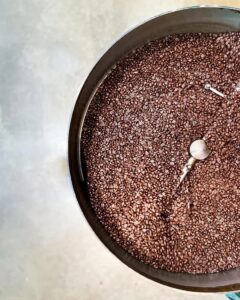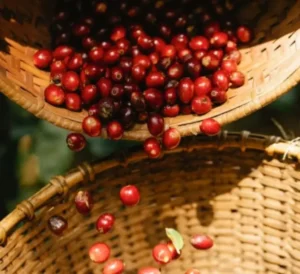If you’re interested in coffee, you may have heard of the second or third “wave” of coffee. Waves of coffee culture distinguish relationships between coffee drinkers and the world’s second favorite beverage. It didn’t always have such variety and transparency of sourcing. Nevertheless, US (and colonial) history does hold interesting points about coffee. When people refer to the three “waves of coffee” from the past, they’re talking about changes in the relationships between producers, consumers and the coffee consumers hope to buy. Looking at coffee’s history and focusing on the context for the first wave, and its characteristics, shows how far consumer awareness and the chains of trade bringing coffee to you have come.
What is a “Wave of Coffee”?

Coffee doesn’t grow well in the vast majority of the US. Since it first arrived in colonial times, it had to be imported. Coffee had been brought to the Americas during the colonial period. Closer to the equator, in Central and South America, coffee grew splendidly.
American colonists turned to coffee when tea was taxed. It was around for decades, but the taste wasn’t often pleasant. The first national condoning of coffee took place when soldiers were given a coffee ration during the Civil War. Coffee began to get more pleasant and widely popular in the 1920s and 30s. However, it is very non-uniform and thin due to problems with roasting.
Roasting is an infamously difficult process, especially without modern equipment and tracking. Roasters must beware the bean’s shape, size and density when deciding on roasting temperatures and cycles. Coffee beans (seeds from the coffee fruit) vary from farm to farm and season to season. Adding the additional levers that roasting entails multiplies the number of factors. People weren’t particularly enthralled with the taste of the bitter, dark coffee available in the 1800’s and early 1900’s. Most people who drank it just wanted the energy. For example, middle-aged parents drank a lot of coffee. Overall, consumers desired more consistency from their coffee, because roasting at home, or purchasing from early roasters, left a lot to be desired.
Rising Uniformity – The First Wave
There isn’t a consensus about when the First Wave of coffee occurred. The coffee wave designations pertain to the culture of a highly variable product, roasted coffee beans, throughout a large area, the growing United States. Since a “wave” is the name for changes in coffee culture, it’s best understood by being compared to what coffee drinkers wanted in the later waves. In the second wave, for example, coffee drinkers wanted better-tasting, fresher coffee. However, from the late 1800’s until about the 1950’s, most coffee drinkers lacked access to a supply of coffee with consistent properties and taste. Therefore, during the first wave, over decades, an increasing number of consumers craved consistency. Coffee at that time tended to be dark and bitter and people couldn’t choose between tastes because consistency was still the major problem.
Coffee and the Old West
 When a roaster finally met cowboys’ needs for easy-to-brew, consistent coffee, it helps us trace the beginning of the first wave of coffee. While eastern cities offered pre-roasted coffee to some lucky consumers, westward migration left pioneers and fortune-seekers with a dearth of roasted coffee, besides the beans they could carry. The gold rush in California provided more than just an opportunity to strike it rich. Men who provided goods and services to the miners often made impressive profits. Out west, people longed for coffee that wasn’t laborious to brew. Cowboy coffee is a particular term originating in the Old West.
When a roaster finally met cowboys’ needs for easy-to-brew, consistent coffee, it helps us trace the beginning of the first wave of coffee. While eastern cities offered pre-roasted coffee to some lucky consumers, westward migration left pioneers and fortune-seekers with a dearth of roasted coffee, besides the beans they could carry. The gold rush in California provided more than just an opportunity to strike it rich. Men who provided goods and services to the miners often made impressive profits. Out west, people longed for coffee that wasn’t laborious to brew. Cowboy coffee is a particular term originating in the Old West.
Folger’s Coffee Company was started by William Bovee and James Folger. James migrated to California, began working as a carpenter and met Bovee. Bovee’s coffee roasting experience in the East led them to create the simple Pioneer Coffee. Later, James took over and passed the company down to his heirs. Between tins of coffee and later on, bulk-roasted coffee sold in grocery stores, corralling coffee into a predictable product with a consistent taste was a feat Folger’s achieved over time.
James Sanborn and Caleb Chase also found success with consistent coffee in New England. In 1874, they started a coffee and tea company with their own name. They were the first to ship coffee in tins that were sealed. Maxwell House was founded in 1892 and went on to become a major player in uniform coffee.
Returning to the history of coffee during westward expansion, John Arbuckle’s Ariosa Coffee also made waves by meeting pioneers and cowboys where they were: without the time or resources to roast coffee beans. Ariosa’s recipe is sealed in flavor by adding Irish moss, along with a sugar and egg coating. They could be packed up for cowboys to roast wherever, whenever.
As coffee roasters kept meeting the demand for standardization, the “First Wave” of modern coffee occurred. Since trade to rural areas was limited and the first mass-produced coffees didn’t taste great, the first wave really occurred over the course of decades. The overall history of coffee culture, including all the waves, is very interesting.
The Desire to Purchase and Brand Loyalty
Since coffee doesn’t grow locally in the US, it was ripe for marketing and creating loyal customers. However, the company’s coffee needed to prove uniformity first. The reason coffee could be targeted for marketing, like the quintessential packaging of Ariosa, is that coffee doesn’t grow locally in the US, outside of a few islands. Better shipping lines and food produced in volume allowed grocery stores to offer products from further and further away. Still, many people continued growing their own vegetables and making their own jelly, for example. However, an increasing number of people stopped rolling their own pasta and baking their own bread. That’s because ubiquitous food products were saving time.
Despite these changes, Americans and Canadians still couldn’t grow their own coffee beans. They couldn’t take pride or enjoyment in the process like they did with growing vegetables or making jam. A few people probably continued to enjoy roasting their own green coffee beans. Nevertheless, roasting beans is a laborious process. It requires tight control to achieve consistency. Therefore, coffee was one aspect of home purchasing where companies that created a consistent, salient, widely available brand reaped rewards.
Coffee was a pioneer in the trends that would lead to household items and food products becoming more standardized and identifiable due to special branding. In the mid-twentieth century, the concepts of “marketing” and “brand loyalty,” pushed into new territory. Consumers were targeted like never before by companies who appealed to their emotions. They dove deep into creating tactics to beat their competitors who were nearly identical, by understanding and controlling the consumer experience. Think of brands like Lipton, Proctor and Gamble, and Kraft, big names who led the pack in marketing. Advertising efforts started with packaging. Promotion and advertising looped in to draw and keep customers. If you can finish the diddy: “The best part of waking up…” you’ve witnessed the effects of great advertising.
The Trouble with Big Coffee Brands
Ariosa and the big companies producing consistent coffee had their time when they pushed the coffee industry further and met consumer demand. However, nowadays, mass-produced coffee usually involves shortcuts. Shortcuts, and cutting to the facts: they include toxins. Pesticides, herbicides and GMO coffee produced by big companies plague the coffee aisle today. Consumers shouldn’t have to settle for shortcuts just because coffee doesn’t grow well in the US. Grocery store shelves aren’t bursting with healthy, sustainably grown coffees. Many of the big coffee brands don’t use sustainable labor. In fact, many don’t even really know who grows, harvests and transports their coffee. These companies may not even know or keep track of the chemicals being used.
Subida Coffee Co.
Meanwhile, Subida Coffee Co offers delicious, single-origin coffee that gives consumers a compelling reason to be loyal to their brand: offering youth education. These high-altitude coffee beans from Honduras are available whole or ground. Subida still takes the work out of roasting, by firing small batches into consistent medium and dark roasts. This non-profit coffee operation in Santa Rosa de Copan, Honduras, educates teenage boys and provides them with agricultural training. It’s also pushing coffee beans from Honduras higher on the list of the world’s best-tasting coffees.

